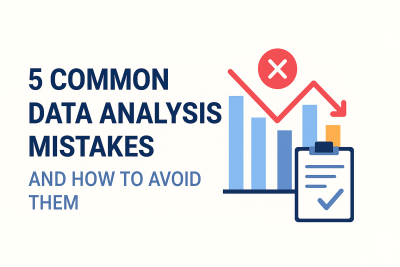
SOPHIA OLISE
 Data Analysis
Data Analysis
 0 comment
0 comment
 16 Aug, 2025
16 Aug, 2025

In today's competitive landscape, data analysis is more than just a skill—it's a critical driver of business success. But as the volume and complexity of data grow, so does the potential for error. A single mistake in your analysis can lead to flawed insights, misinformed strategies, and significant financial losses. While data is an invaluable asset, its true power is unlocked only when the analysis is conducted with precision and care.
Consider a retail company that mistakenly identifies a low-performing product due to faulty data, only to discontinue it and lose a key revenue stream. Or a healthcare provider that misinterprets patient data, leading to an incorrect diagnosis. These scenarios highlight a crucial truth: bad analysis can be far more damaging than no analysis at all.
This is why, regardless of your expertise, a proactive approach to avoiding common pitfalls is essential. It's the difference between a data-driven strategy that thrives and one that crumbles under the weight of inaccurate information. In the following sections, we'll explore the most frequent mistakes made in data analysis and provide actionable steps to ensure your insights are not just a collection of numbers, but a reliable foundation for smarter, more confident decision-making.
The impact of errors in data analysis extends far beyond a simple miscalculation; it can have ripple effects that undermine a business's core operations and strategic direction. These mistakes can manifest in several critical areas:
By recognizing these serious consequences, data professionals and business leaders can appreciate the vital importance of accuracy. The goal is to build a culture where data integrity is paramount, ensuring that every insight is not only useful but also reliable and trustworthy.
1. Poor Data Quality : This is arguably the most fundamental error in data analysis. Poor data quality, characterized by incomplete, outdated, or inaccurate information is a one-way ticket to flawed insights. The principle of "garbage in, garbage out" is a universal truth in this field. Relying on bad data means that no matter how sophisticated your analysis, your conclusions will be unreliable, leading to poor decisions and wasted resources.
How to Avoid It: The solution lies in proactive data governance. Before you begin any analysis, you must clean and validate your datasets. This involves a systematic process of identifying and removing duplicate records, correcting errors, filling in missing values, and ensuring all data sources are up to date. Establishing automated data validation checks and a routine data maintenance schedule can help ensure the integrity of your information at all times.
2. Ignoring the Context : Numbers alone can be deceptive. Without context, data can be misinterpreted, leading to flawed conclusions. A simple increase in website traffic, for example, might seem positive until you realize it was caused by a bot attack, not new visitors. Similarly, a dip in sales might look bad until you remember it was a public holiday. Ignoring the bigger picture, the market, seasonal trends, and external events is a common pitfall.
How to Avoid It: Always pair quantitative data with qualitative insights. Before you analyze, gather a holistic understanding of the business environment. Talk to sales teams, review marketing calendars, and monitor industry news. This contextual knowledge will help you interpret the numbers accurately and tell the complete story, preventing misjudgments and providing a richer, more meaningful analysis.
3. Overcomplicating the Analysis : While complex models and advanced algorithms have their place, using them without a clear purpose can be a costly mistake. Overcomplicating the analysis can confuse stakeholders, obscure the key findings, and make your insights less actionable. If the method is too convoluted, your audience may not trust the results or understand how to implement them.
How to Avoid It: The goal is not to demonstrate technical prowess, but to deliver a clear, actionable insight. Keep your analysis as simple as possible while still addressing your objectives. Use straightforward charts, tables, and explanations that your audience from executives to team members can easily understand. A simple line graph that clearly shows a trend is often far more effective than a complex predictive model that no one can interpret.
4. Confirmation Bias is the human tendency to seek out and interpret data that supports our existing beliefs or hypotheses. This is a dangerous trap in data analysis, as it can lead you to ignore contradictory evidence, miss key risks, and overlook unexpected opportunities. Instead of letting the data lead you to the truth, you're subconsciously forcing the data to align with your preconceived notions.
How to Avoid It: Approach every analysis with an open and objective mind. Formulate multiple hypotheses even ones that challenge your initial beliefs and test them rigorously. Be prepared to accept findings that contradict your assumptions. A good practice is to have a peer review your work to ensure your conclusions are unbiased and are fully supported by the evidence.
5. Lack of Follow-Up : An analysis is not complete until you have measured its real-world impact. Lack of follow-up is a critical mistake that leaves the process unfinished and prevents you from learning what works and what doesn't. You might have made a brilliant recommendation, but if you don't track its performance, you'll never know if your analysis actually delivered the expected results.
How to Avoid It: Always include a follow-up plan in your analysis. After a recommendation is implemented, establish a clear set of metrics to monitor its performance. Set a timeline to review the results and determine if the outcome aligns with your predictions. This not only validates your work but also provides valuable feedback for improving your analytical process and building a more effective, data-driven strategy.
1. Define Clear Goals: Before you touch any data, you must know what you're trying to achieve. Defining clear goals means translating a business question into a measurable objective. Instead of a vague goal like "improve sales," a clear objective is "identify the top 3 customer segments that contribute most to revenue so we can create targeted marketing campaigns." Without a well-defined question, your analysis will lack focus and direction, leading to a waste of time and resources.
2. Choose the Right Tools: The software you use should be a good fit for your specific needs. Choosing the right tools means considering your business size, budget, and your team's skill set. A small business with a limited budget might start with Microsoft Excel or Google Sheets for basic analysis. As your data volume and complexity increase, you might graduate to more powerful and scalable tools like Power BI or Tableau. Using a tool that is too complex for your needs can lead to a steep learning curve and underutilization, while a tool that is too simple can limit your analytical capabilities.
3. Document Your Process: To ensure your analysis is repeatable and trustworthy, you must document your process. This involves keeping a detailed record of every step you take, from data collection and cleaning to the formulas you use and the sources of your data. This practice provides transparency and reproducibility. If a colleague needs to replicate your analysis or a stakeholder wants to understand how you arrived at a certain conclusion, a well-documented process makes it easy to trace your steps, which builds confidence in your work and your findings.
4. Collaborate: Data analysis should not be a solitary activity. Collaboration is key to a robust analysis. Involving team members from different departments, such as sales, marketing, and operations, can provide diverse perspectives and valuable context. They can help validate your findings and interpretations, challenge your assumptions, and spot potential errors you might have missed. This collective input ensures that your insights are not only accurate but also relevant and actionable across the entire organization.
Data analysis can be a game-changer for decision-making, but only when it is accurate and free from common pitfalls. By focusing on data quality, providing context, avoiding unnecessary complexity, checking biases, and tracking results, you can significantly improve the effectiveness of your analysis. The goal is not just to analyze data but to turn it into actionable, trustworthy insights.
Avoid the Pitfalls, Master the Process!
Mistakes in data analysis can cost you valuable insights, opportunities, and even business growth. The good news? You don’t have to repeat them.
At ECR Academy, we equip students, young professionals, and businesses with practical training that helps you not just analyze data, but analyze it the right way.
Whether you're starting or upgrading your tech skills, you can begin your learning journey with us today.
Review Affordable Tech Course with us at ECR Academy We provide the hands-on, project-focused training you need to master tech skills like Digital Marketing, Web development, Data Analysis, Cybersecurity.
Build Comprehensive Digital Solutions with ECR Technology Services Limited Let us help you bring your brand, business, or idea online with professional digital solutions such as secure, responsive websites, robust mobile applications, high-impact digital marketing templates, and specialized Learning Management Systems (LMS).
Contact Us Today:
SOPHIA OLISE
Data Analyst
Olise Sophia Amarachi is a passionate and purpose-driven data analyst and digital skills advocate based in Nigeria. With a strong foundation in Excel, Power BI, and SQL, she empowers others—especially young people and corps members—through practical training, tech mentorship, and values-based leadership. Sophia’s journey into data analysis began during her NYSC year in Abia State, where she committed herself to learning and growing from scratch. Today, she shares her knowledge through online classes, challenges, and hands-on projects, including dashboards and reports that translate complex data into clear insights.
0 comment